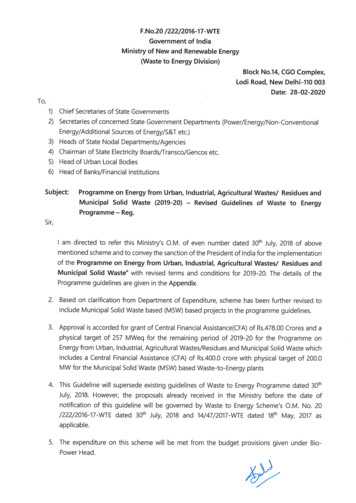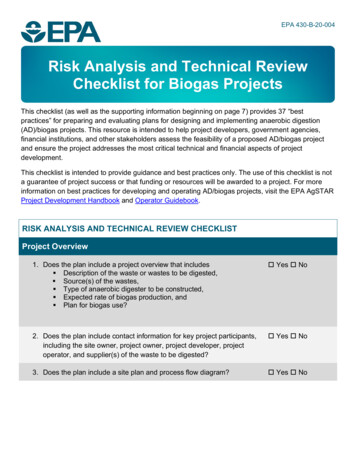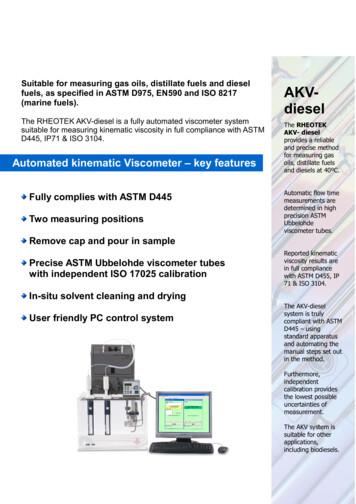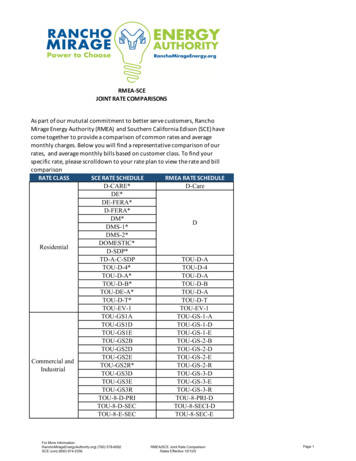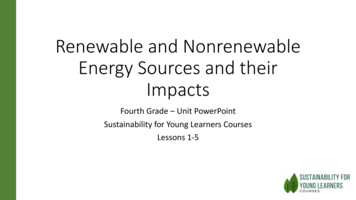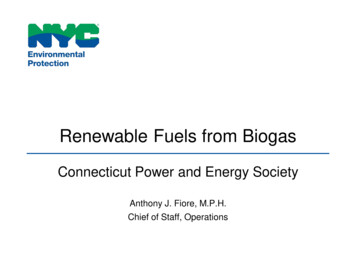
Transcription
Renewable Fuels from BiogasConnecticut Power and Energy SocietyAnthony J. Fiore, M.P.H.Chief of Staff, Operations
NYC LandfillsPelham Bay LF Operations - ‘63-‘78 Area – 80 acres LFG Produced – 192M ft3/yr Methane – 84M ft3/yrFreshkills LF Operations – ‘48-’02 Area - 2,200 acres Landfill gas collection anddistribution into natural gas system 365M ft3/yr (50% processed)Brookfield LF Operations – ‘66-’80 Cap being installed Area – 270 acres LFG Produced (est.)- 115M ft3/yr Methane (est.) – 58M ft3/yrPenn Ave. LF Operations – ’56-‘72 Area – 100 acres LFG Produced - 42M ft3/yr Methane – 9.7M ft3/yrFountain Ave. LF Operations - ‘63-’85 Area - 280 acres LFG Produced - 973M ft3/yr Methane - 254M ft3/yrEdgemere LF Operations – ‘38-’91 Area - 160 acres LFG Produced – 163M ft3/yr Methane – 48M ft3/yr2
System Overview3
History of Cogeneration UseMater Plan: Original Master Plan WWTP design conceptincluded anaerobic digestion and use of biogas asa fuel source for cogeneration. Coney Island WWTP was one of the first to usedigester gas as an energy source to operate theplant 1950’s and 1960’s 9 out of 12 WWTPs had some form ofcogeneration which met most of the energyprocess needsEnterprise DGSR-46 Dual Fuel Engine 1980’s The North River, Coney Island, Owls Head,Tallman Island and Newton Creek WWTP’soperated with enginesMirrless Blackstone KP-5 major dual fuel engine4
Process Layout of NYC WWTP - Original5
Process Layout of NYC WWTP - Current6
History of Cogeneration Use (Continue) 2000’s 2 fuel cells (200 kW each) were installedat the Red Hook WWTP in 2003 1 fuel cells (200 kW) was installed at theOakwood Beach WWTP in 2003 2 fuel cells (200 kW each) were installedat the 26th Ward WWTP in 2003 3 fuel cells (200 kW each) were installedat the Hunts Point WWTP in 2004.Fuel Cells at the 26th Ward WWTPFuel Cells at the Hunts Points WWTP7
Current Status of Cogeneration North River WWTP Ten engines were installed (turbocharged dual fuel each 2246 hp/1600kw) 5 direct drive engines for the mainsewage pumps 5 direct drive engines for theblowers Waste heat recovery: Recovery of heat from engine forsludge heating, service water, andHVAC needs8
Current Status of Cogeneration (Continue) Owls Head WWTP Three engine generators wereinstalled (turbo charged dual fuel each2246 hp/1600 kw) These cogeneration units have beenin service for last 25 years The plant is deriving 40% of totalelectric power from engine generators Waste heat recovery: Recovery of heat from engine forsludge heating, service water, andHVAV needs Plant will be using two enginegenerators simultaneously to increasethe cogeneration capacity.9
Current Status of Cogeneration (Continue) Tallman Island WWTP Five direct drive pump enginesDeLaval dual fuel 2 @ 520 hp, 3@ 546 hp installed Five direct drive blower enginesDeLaval 1,013 hp each The plant is using most of theelectric power from the enginegenerators Waste heat recovery: Recovery of heat fromengine for sludge heating,service water, and HVACneeds10
Current Status of Cogeneration (Continue) Coney Island WWTP Four engine generators were installed(turbo charged dual fuel each 2246hp/1600 kw) These cogeneration units has been inservice for last 25 years The plant is deriving 80% of totalelectric power from engine generatorsand utilize 100% digester gasproduction at plant Waste heat recovery: Recovery of heat from engine forsludge heating, service water, andHVAC needs11
Forward thinking - Integration into WWTPs Challenges Air emissions Public Acceptance Space Limitation Working in parallel with grid Benefits Mitigation of increasing electricalrates Reliability Flexibility in operations Capital Cost Possible elimination of fuel oil andassociated regulatory requirements Technologies are more complicatedand evolving quickly Reduce greenhouse gas emissions Site specific issues Participation in demand responseprograms for additional revenuestream12
Recommendations Perform a thorough feasibility study Detailed electric and thermal profiles need to be created Use as fine-grained data as available (15-minute interval metering data, thermalhourly load profiles) Validate with energy balance13
Recommendations (continued) Tightly define scope of project Run sensitivity analysis for a range of forward energy prices Size appropriately Factor in potential revenue streams from demand and market response programs Consider stand-by tariff rates Work closely with utility early on Consider extraneous benefits14
Questions to Ask Is a cogeneration application at the plant a technically, operationally andeconomically viable alternative for consideration? Under what circumstances does the proposed cogeneration system becomeuneconomic? What is the estimated total project cost and total installed capacity for the installationof this project? What are the economics for the cogeneration plant investment based upon a rangeof future energy cost projections? What are the right financial metrics to measure the project (e.g., simple payback,ROI, IRR, NPV, etc )? What are the three greatest risks to viability of the cogeneration project? What is the cogeneration system’s net impact to the plant’s greenhouse gasemissions and to the plant’s air permit? Is there a negative impact in terms of a greater volume of emissions, noise, traffic,and risk of a catastrophic event on the site and to the neighbors of the cogenerationsystem versus the present equipment? Where will the cogeneration equipment be located? How long will the project take to design, permit, and construct?15
Breaking from the Traditional Paradigm – A Case Study In an effort to reduce greenhouse gas (GHG) emissions,foster and develop local renewable energy resources andposition New York City to be a leader in deliveringinnovative solutions in a new low carbon economy,National Grid and DEP are working together to deliverthis renewable gas project at the Newtown CreekWastewater Treatment Plant (Plant). This is a frontier project for the utilization of renewablegas, and is one of the first examples in the U.S. of amunicipal or private water utility partnering with anatural gas utility to inject treated anaerobic digester gasfrom a wastewater treatment plant into the local gasdistribution system. The wastewater treatment process produces a significantamount of anaerobic digester gas (ADG), enough to heat2,500 homes a year. This ADG is used at the Plant on alimited basis but for the most part it cannot be used byDEP in its current state. The excess ADG not used at thePlant is flared into the atmosphere.16
A Case Study– Plug and Play National Grid will install a purification system to remove carbon dioxide and unwantedcompounds from DEP’s ADG produced at the Plant. The resulting gas will be injecteddirectly into National Grid’s gas distribution system for consumption by local customers.FlowADG PurificationProcess17
Case Study - Environmental Benefits Beneficial use of the ADG helps to achieve GHG reduction targets proposed by both NYCand National Grid. Using the Plant’s ADG will offset National Grid’s purchase of natural gas generated fromtraditional sources. This will result in a GHG reduction of approximately 15,000 metric tons of CO2 per year. Equivalent to the removal of almost 3,000 vehicles from the road. Will provide enough gas to heat approximately 2,500 homes per year.18
Case Study - Project Description Total footprint isapproximately 7,000 ft2.A Other equipmentincludes:BA. A smalltransformer;CB. A motor controlcenter;C. A small monitoringstation; andD. Two compressors.DMechanical Equipment3D Model1919
Case Study - Design Considerations Acoustic enclosure on compressors and sound mitigating screening wall to reducenoise levels and meet or exceed NYC Noise Prevention Code. Process shutdowns revert ADG back to Plant flares consistent with currentoperations. Designed and constructed to same codes as any other commercial project. Minimal waste streams, typically oil changes & filters. No odors due to this project. No permanent gas storage or tank farm. Minimal vehicles needed for operation; site is designed for temporary, off-streetvehicle parking.2020
Case Study - Construction Construction is expected to begin Summer of 2013. Standard daytime construction hours planned. Construction will include: Site preparation: footings, foundations, pads Rigging and setting of the skid mounted equipment Plumbing work to run piping and valving Electrical connections Gas main extension from project site to Russell & Calyer Street intersection Monitoring station2121
Case Study - Operation Facility commissioning is expected in 2013. Equipment will be electronically monitored by National Grid staff 24/7. A National Grid technician will visit the site daily during the work week. Monitoring equipment will be tied into the Plant’s Control Room. Plant personnel will perform visual inspections during their routine rounds. Facility will be operated to maximize gas throughput thereby providing the greatest benefits. Reduce greenhouse gas emissions Sustainable fuel that can be used in existing natural gas appliances A renewable energy project cost competitive with traditional supply sources New revenue stream to City in time of economic downturn2222
Case Study - City Contribution to Project Preferential electricity rates through NYPA Free Land Use of existing infrastructure Labor with certificates that meet FDNY regulatory requirements O&M assistance Free water and sewer connections2323
Questions and AnswersQuestions?24
Ward WWTP in 2003 3 fuel cells (200 kW each) were installed at the Hunts Point WWTP in 2004. Fuel Cells at the 26. th. Ward WWTP Fuel Cells at the Hunts Points WWTP . 8 . Current Status of Cogeneration North River WWTP Ten engines were installed (turbo charged dual fuel each 2246 hp/1600


